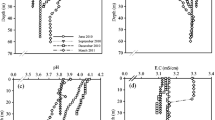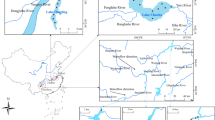Abstract
Several floodplain lakes of the Orinoco River have been impacted by alkaline alumina-refining waste including red mud, a by-product from the Bayer process. Some of these impacted lakes have undergone algal overgrowth, which has been detected due to the unusual green color of water and the dissolved oxygen oversaturation. Thus, we conducted sampling campaigns in impacted and non-impacted lakes to measure the concentration of nitrogen (N) and phosphorous (P) in water to detect any change in the nutrient levels. Despite the content of N and P in red mud is low, our findings suggest that N is released from red mud accumulated in bed sediments to the water column in the impacted lakes, increasing the content of total N. However, the total P concentrations in impacted lakes were not affected from their background values probably due to the strong adsorptive behavior of P onto red mud minerals.


Similar content being viewed by others
References
American Public Health Association, American Water Works Association, Water Environment Federation (APHA) (1995) Standard Methods for the Examination of Water and Wastewater, 19th ed., Washington.
Angel BM, Figuiere R, Simpson SL (2020) Predicting chronic algal toxicity from 1- to 48-h pulsed exposures to mine site waters using time-averaged concentrations. Ecotoxicol Environ Safety 192:110263
Bouchoucha M, Chekri R, Leufroy A, Jitaru P, Millour S, Marchond N, Chafey C, Testu C, Zinck J, Cresson P, Mirallès F, Mahe A, Arnich N, Sanaa M, Bemrah N, Guérin T (2019) Trace element contamination in fish impacted by bauxite red mud disposal in the Cassidaigne canyon (NW French Mediterranean). Sci Total Environ 690:16–26
Carlson R (2007) Estimating trophic state. Lakeline 27:25–28
Czop M, Motyka J, Sracek O, Szuwarzyński M (2011) Geochemistry of the hyperalkaline Gorka Pit Lake (pH>13) in the Chrzanow Region, Southern Poland. Water Air Soil Pollut 214:423–434
Guo T, Yang H, Liu Q, Gu H, Wang N, Yu W, Dai Y (2018) Adsorptive removal of phosphate from aqueous solutions using different types of red mud. Water Sci Technol 2017:570–577
Hamilton SK, Lewis WM (1987) Causes of seasonality in the chemistry of a lake on the Orinoco River floodplain, Venezuela. Limnol Oceanogr 32:1277–1290
Hamilton SK, Lewis WM (1990) Basin morphology in relation to chemical and ecological characteristics of lakes on the Orinoco River floodplain, Venezuela. Arch Hydrobiol 119:393–425
Klauber C, Gräfe M, Power G (2011) Bauxite residue issues: II Options for residue utilization. Hydrometallurgy 108:11–32
Kong T, Mendelssohn IA (1996) The impact of red mud on growth of wetland vegetation and substrate fertility. Wetl Ecol Manag 4:3–14
Lacatusu R, Kiselev A, Rizea N, Lungu M, Lazar R, Stanciu-Burileanu MM, Vrinceanu N, Stroe VM, Popa RG, Filipescu L (2014) Plant growth suitable nutritive red mud composite materials from the Romanian dry landfield red mud. I. Red mud chemical and agrochemical characterization. Rev Roum Chim 65:1008–1014
Lewis WM, Hamilton SK, Lasi MA, Rodríguez M, Saunders JF (2000) Ecological determinism on the Orinoco floodplain. Bioscience 50:681–692
Lewis WM, Wurtsbaugh WA, Paerl HW (2011) Rationale for control of anthropogenic nitrogen and phosphorus to reduce eutrophication of inland waters. Environ Sci Technol 45:10300–10305
Liang Z, Peng X, Wang J, Luan Z, Liu Z, Wang Y (2011) Immobilization of phosphorus in sewage sludge using inorganic amendments. Environ Earth Sci 63:221–228
Lin J, Kim M, Li D, Kim H, Huang C (2020) The removal of phosphate by thermally treated red mud from water: The effect of surface chemistry on phosphate immobilization. Chemosphere 247:125867
Mora A, Pisapia D, González N, Handt H, Moreau C, Vásquez Y, Márquez L, Alfonso JA (2015) Impact of the red mud disposal on several floodplain lagoons of the lower orinoco river. Water Air Soil Pollut 226:179
Mora A, Mahlknecht J, Baquero JC, Laraque A, Alfonso JA, Pisapia D, Balza L (2017) Dynamics of dissolved major (Na, K, Ca, Mg, and Si) and trace (Al, Fe, Mn, Zn, Cu, and Cr) elements along the lower Orinoco River. Hydrol Process 31:597–611
Narayan A, Mora A, Sánchez L, Rosales J (2020) Temporal and spatial variability of heavy metals in bottom sediments and the aquatic macrophyte Paspalum repens of the Orinoco River floodplain lagoons impacted by industrial activities. Environ Sci Pollut Res 27:37074–37086
Olszewska JP, Meharg AA, Heal KV, Carey M, Gunn IDM, Searle KR, Winfield IJ, Spears BM (2016) Assessing the legacy of red mud pollution in a shallow freshwater lake: Arsenic accumulation and speciation in Macrophytes. Environ Sci Technol 50:9044–9052
Olszewska JP, Heal KV, Winfield IJ, Eades LJ, Spears BM (2017) Assessing the role of bed sediments in the persistence of red mud pollution in a shallow lake (Kinghorn Loch, UK). Water Res 123:569–577
Rivera CA, Zapata AM, Pérez D, Morales Y, Ovalle H, Alvarez JP (2010) Caracterización limnológica de humedales de la planicie de inundación del río Orinoco (Orinoquía, Colombia). Acta Biol Colomb 15:145–166
Smith R, Kalff J (2002) Limnology: Inland Water Ecosystems. Prentice Hall, NJ
Summers RN, Pech JD (1997) Nutrient and metal content of water, sediment and soils amended with bauxite residue in the catchment of the Peel Inlet and Harvey Estuary, Western Australia. Agric Ecosyst Environ 64:219–232
Tosiani T, Meléndez W, Vivas F (2006) Modeling humic acids transport in a bauxite profile: Los Pijiguaos, Venezuela. J Geochem Explor 88:246–248
Verhoeven JTA, Arheimer B, Yin C, Hefting MM (2006) Regional and global concerns over wetlands and water quality. Trends Ecol Evol 21:96–103
Wendling LA, Douglas GB, Coleman S, Yuan Z (2012) Nutrient and dissolved organic carbon removal from water using mining and metallurgical by-products. Water Res 46:2705–2717
Winkler D, Bidló A, Bolodár-Varga B, Erdó Á, Horváth A (2018) Long-term ecological effects of the red mud disaster in Hungary: Regeneration of red mud flooded areas in a contaminated industrial region. Sci Total Environ 644:1292–1303
Acknowledgements
This study was performed under the Lower Orinoco River Corridor Project (UNEG‐CIEG). The valuable suggestions of two anonymous reviewers considerably improved the paper.
Author information
Authors and Affiliations
Corresponding author
Additional information
Publisher's Note
Springer Nature remains neutral with regard to jurisdictional claims in published maps and institutional affiliations.
Rights and permissions
About this article
Cite this article
Narayan, A., Mac-Quhae, C., Rosales, J. et al. Does Alumina-Refining Waste Increase the Nutrient Level in Tropical Mesotrophic Floodplain Lakes?. Bull Environ Contam Toxicol 107, 506–513 (2021). https://doi.org/10.1007/s00128-021-03279-4
Received:
Accepted:
Published:
Issue Date:
DOI: https://doi.org/10.1007/s00128-021-03279-4




